| [an error occurred while processing this directive] |
| My Guzzi Desert racers |


The bikes performed better than the Press expected, who were tipping the V50s wouldn't reach Africa - but in fact they were amongst the fastest on the mainland. When they crossed to the desert the alloy rear wheel in the dunes proved to be the achilles' heel for most of the five bikes - breaking spokes because of the side loads imposed by the sand. In the end only one rider, Rigoni, made it to the finish in 48th place after cannibalising parts from the other teamates' bikes. The next year another pair of V50 based bikes were entered, and again in 1981 the French riders started a total of three V50 specials, but none of these subsequent entrants finished the event.
In 1984 an Architect from Bergamo, Mr. Torri approached Moto Guzzi with the idea of competing in the Paris-Dakar with a factory built twin. He offered to meet some of the expenses in developing a bike for him to ride in the next Dakar, and was given access to the experimental section of the factory workshop and assigned an engineer, Serafino, to help him build a bike. Within a short time the pair had modified the just-released V65 TT trail bike, fitting the basic necessities of a long distance desert racer: long suspension, huge fuel tank, and extended wheelbase for sand riding stability.
Torri, riding the V65 factory special, and Serafino, driving a small Fiat 238 Van as the support vehicle started in the 1985 Dakar race. Overshadowed by the likes of the Ligier-Cagiva team with their helicopter and support trucks, Moto Guzzi's attempt at the Dakar may have gone unnoticed, but Torri managed to go "missing" in the desert for a short while after all of the spokes in the rear wheel broke, and that rated an article in the Italian newspapers. Unfortunately Torri didn't finish the Dakar, but the attempt had winning results for Moto Guzzi. Pictured below (1) is Torri at the Dakar, and also his restored bike which is now owned by an enthusiast in Mandello.
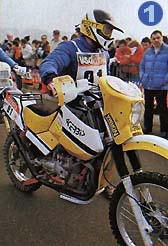

Torri was seen by the French Moto Guzzi importer, who was so impressed by the special he approached the Moto Guzzi factory and negotiated an order of 15 similar bikes. This number of bikes qualified them as a model which needed a name: so the Baja was born.
The Baja model was based on the V65 TT, and the heritage is seen by the letters "TTC" (Tutto Terenno Competizione) screen printed on the seats. The bikes were all hand-made in the experimental workshop, principally by Serafino. The tank for Torri's bike was a 50 litre monster, but that was reduced to 40 litres for the production series.
The fuel tanks were hand-beaten aluminium, and made initially by one man at the rate of one a week, which limited the speed of construction, until another worker was enlisted to double the output. The seats were hand-made by SDM, and covered in suede. The fairing and front and rear mudguards were off-the shelf Acerbis items modified to fit, but the sidecovers were specially made for the Baja in ABS plastic. The headlight stoneguard, the quick-detach instrument cluster and rear luggage rack were hand-made, and you can see small differences in these components between individual bikes. So too, the frames show subtle differences in the shock absorber and other critical mounting points The forks and shock absorbers were the Marzocchi M1 and MX series, with Akront 21 inch and 17 inch rims laced to Cagiva Elefant front hub holding a floating Brembo disc. A standard Guzzi rear hub from the LeMans, a LeMans swinging arm and final drive housing was adapted to fit on the small twin's gearbox replacing the cast alloy standard part. This modification extended the wheelbase, eliminated the possibility of breakage and allowed a better range of final drive ratios to be used. The electric starter motor was removed, and the battery space was given over to a hand-made alloy aircleaner box with provision for a small 12 volt battery on one side. The standard V65 ignition and charging system was used. To start the bike without the "electric foot" meant the NATO (military) model V50 gearbox kickstarter was fitted and adapted to provide a left-side, short-throw kickstart which folds up neatly under the gearbox. The engines have a few internal performance modifications and are fitted with external oil coolers.
From 1984, a total of 17 Baja bikes were constructed over 2 years, beginning with Torri's bike and ending with an example to put in the Mandello factory museum, (pictured below)
While they didn't make the stage in Dakar, they did make the grade in many of the local European rallies like the Titan Rally, and remained in competition long past 1984.

Following the Baja series of bikes only 4 or 5 other Guzzi desert racers were constructed, all with 750cc engines. The first of these were made in 1985, after the French Guzzi Importer pushed the factory to produce two bikes for the Dakar. The factory decided to use the 4-valve 750cc engine from the newly-released V75. The power output was around 62 HP, which meant the bike could compete with the other twins from Cagiva and BMW.
The prototype of this series was made by fitting the 750 engine into a Baja chassis, which was then used for racing in both France and Spain to get rider feedback on the modifications needed to make it competitive. Below is a photo of the prototype 750 "under test" in France in early 1985.
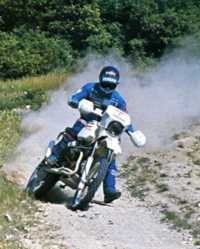
By December 1985 the factory Dakar bikes were ready. The two bikes were similar, not identical - whether it was rider preference or just budget that constrained the team, I cannot say. Still following the Baja layout, the frames were now braced differently and the new air cleaner system had the filter fitted in the front of the 40 litre ABS fuel tank. The regulation 50 litres of fuel needed for the Dakar required another fuel tank filling the underseat area. The #1 bike's exhaust system was handmade in titanium, and probably worth more than the rest of the bike. It paid off in a way because the French press reviewing the bike were amazed at the dry weight of 162 kilograms.


The photos above are the #1 bike in its initial form on the left (clearly showing the beautiful titanium exhaust) and its final form - resting in the Mandello museum - now with the steel exhaust system which was carried as a spare in the event of a crash..
The #2 bike was more like the Baja models before it - although the big tank and suspension upgrades were made, the Baja 2 into 1 exhaust and sump bashplate were retained. However, the frame is different to both the Baja and the #1 bike. Logically, the #2 bike was probably the prototype with further revisions, but without examining more photos of the prototype I cannot say. Each of the 750 engined bikes seem to utilise a different method for fixing the sidecovers, and makes you realise just how handmade and subject to change they were - as another example, on some bikes the sump bashplate is welded direct to the sump and on others it is mounted on brackets from the frame.
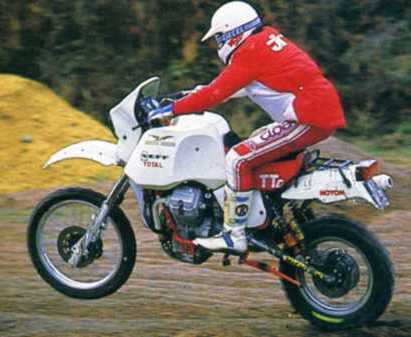
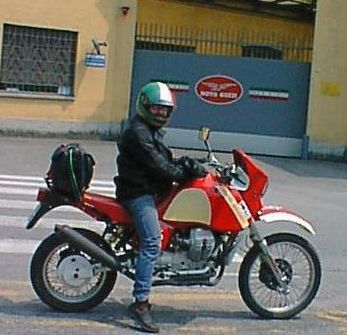
The above photos are of the #2 bike during testing (left) and me at the gates of the Moto Guzzi factory on the same bike 15 years later. The #2 bike is "as found" and has been repainted and modified for road use by fitting an NTX series seat and rear mudguard. The 30cm ground clearance under the sump is obvious in this photo.
In late 1987 the last of the racers was built - a 2-valve 750 using the standard NTX model's 32 litre fuel tank and fairing. It followed the Baja pattern, except for a substitution of the LeMans final drive housing with the newly-strengthened and lighter final drive housing from the current NTX series. It was commissioned by the Australian Moto Guzzi importer in Perth to be used in the Wynn's Safari.
Incredibly, I walked into a Moto Guzzi dealer in Mandello 14 years after the Wynn's bike was made and saw a picture of the bike, Australian importer and rider on the wall of their spare parts department, showing the bikes are not forgotten. In that picture (shown below) the bike is seen in the production NTX yellow paint scheme, but over its competition lifetime the colours changed according to the sponsor of the day. Next to it is a production NTX identical to the first model I owned in Australia.
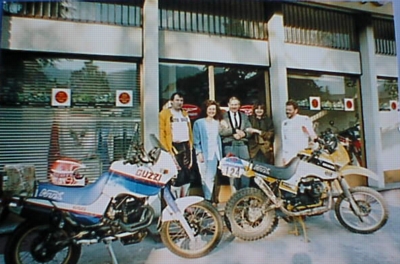
As training for the Safari, rider and bike were sent to Peru for the 1988 Incas Rally (left below) which was finished successfully. The rider was Allan Cunynghame (seen far right above), a notable Australian competitor from the period - who sadly later that year crashed the Yokohama sponsored bike in the Wynn's Safari (below right) as a consequence of front fork failure.
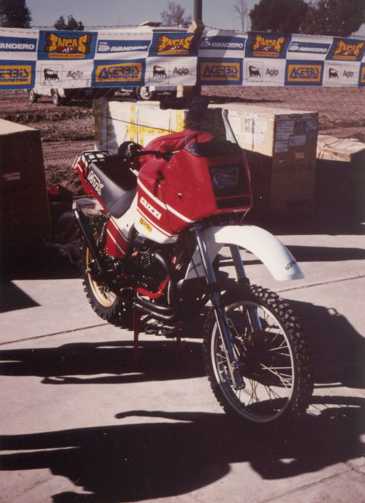
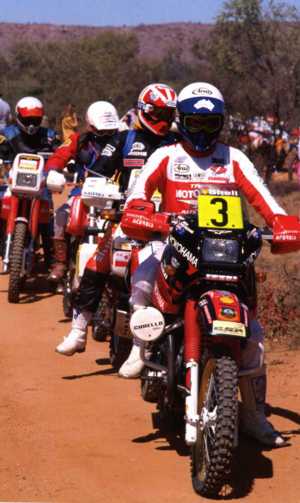
Following the Wynn's Safari, the bike was repaired and sold and used for privateer competition in local enduros, until I purchased it in 1997.
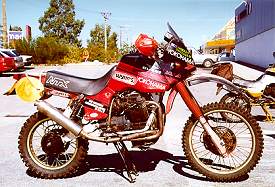
After I rode the Wynn's bike I decided to look for other factory bikes, as it was quite clear that Moto Guzzi could make a dirt-worthy twin. The factory bike was far superior to the production NTX I had at the time, and while it would be possible to build a replica from an NTX, there were too many changes to make it practical. In Italy I first found a good example of the Baja species lurking in a garage - very original, and with a known racing career in the region. And, it came with spare parts which have now been put to good use on the other bikes.

Around the same time I found the 4-valve 750 which was still near Mandello, but converted into a road bike - might seem like a waste, but the bike will do 180kph+ and the tank is good for more than 900 km range. Both excellent attributes for touring in Australia, so I used the bike in Italy for a couple of trips but found the height awkward in the cities. I was unaware of its rarity until much later after the dialogue with Vanni about the history of the Guzzi race department came out in the italian Guzzi forums. Then I realised I should restore it to its former style.
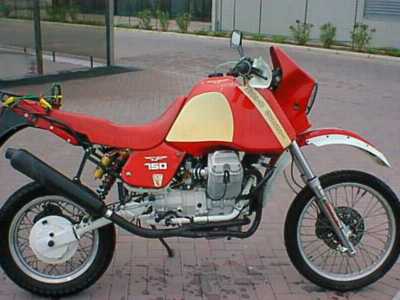
My second Baja was found in France some years ago, and hints at a colourful history - the 50 litre alloy tank with Marlboro sponsorship and Ohlins shock absorbers suggests it was run in the Dakar, which means it was possibly the third Guzzi (and only 650) shown in the entrants listing of the 1986 Dakar, and may have been the bike Torri once again attempted to complete the dakar upon.
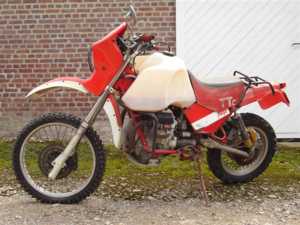
As a series of bikes, they are not esoteric departures from the production version, merely the recipients of upgrades to chassis, suspension and performance as required to do the job in hand. My production Baja is used regularly (photo below) and is not found wanting. - sufficient horsepower for 160+ kph and surprisingly good fuel economy. The comfort is also spectacular thanks to the seat.
And, as you can see below, I have to pay homage to Guzzi because they made a fast, medium weight, competent, comfortable, economical, repairable dual sport 25 years ago - but it does beg the question: "why can't they do it today?"
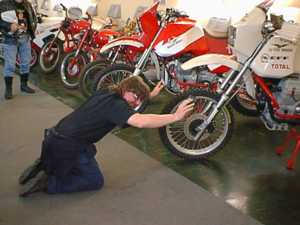
Copyright (c) 2010